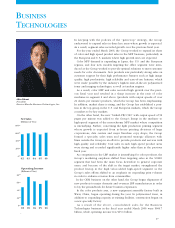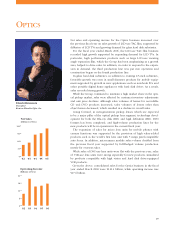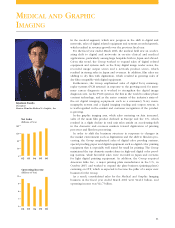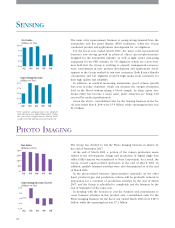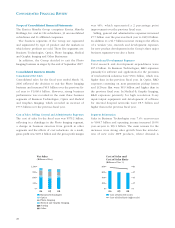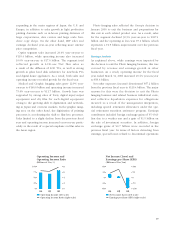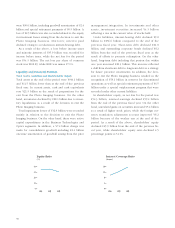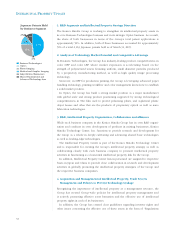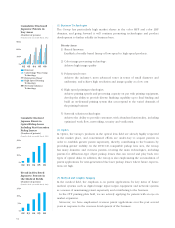Konica Minolta 2006 Annual Report Download - page 28
Download and view the complete annual report
Please find page 28 of the 2006 Konica Minolta annual report below. You can navigate through the pages in the report by either clicking on the pages listed below, or by using the keyword search tool below to find specific information within the annual report.
26
CORPORATE GOVERNANCE
Konica Minolta recognizes that strengthened corporate
governance is a key management issue and is working
to clarify the functional separation of management
supervision and management execution, while at the
same time working to strengthen the functioning of each
to achieve fair and highly transparent management.
The separation of the executive and supervisory
functions is accomplished by a committee-based gov-
ernance structure that includes an Audit Committee, a
Nominating Committee and a Compensation Committee
that are part of the Board of Directors, through which
the Group is working to enhance transparency and
fairness, while at the same time working to speed up
the decision making process.
The supervisory function of the board is ensured
because the majority of the board members are non-
executive directors. A total of seven individuals out of
thirteen board members are directors without executive
functions, including four outside directors, two directors
that serve as committee members, and one director that
serves as chairman of the board. The other six board
members hold executive positions that serve as the pres-
ident and CEO, and executive officers respectively in
charge of corporate strategy, accounting and finance,
compliance, technology strategy, and the Group’s largest
business company.
In addition, outside directors chair each committee.
Moreover, as the president and CEO does not belong to
any committee, we believe this provides for a very
advanced and highly transparent governance structure.
The Nominating Committee is responsible for the
selection of new director candidates based on predeter-
mined selection standards and reviews the process and
reasons for the selection of executive officers before can-
didates are voted on by the Board of Directors. Moreover,
the criteria for the selection of outside directors include
that the candidates have a track record and insights into
their respective fields of expertise, are strongly indepen-
dent, have no important business relationships with the
Group and are able to devote sufficient time in perform-
ing their duties as a board director and a committee
member.
The Compensation Committee determines policies
regarding compensation decisions, and based on these
policies, determines monetary and other compensation
for directors and executive officers. The aim of the
directors’ compensation system is to increase the moti-
vation for directors to strive for the continuous medium-
and long-term improvement of Group performance in
line with management policies to meet shareholder
expectations, and in addition to aim at maintaining a con-
tinuously high level of capable director talent even when
compared to other companies in the same industry,
thereby maximizing the value of the Group as a whole.
Director compensation packages consist of a “fixed
compensation” component and long-term incentives in
the form of “stock remuneration type stock options”
(outside directors receive only “fixed compensation”),
while executive officer compensation packages consist
of a “fixed compensation” component, “performance-
based compensation” as a short-term incentive and “stock
remuneration type stock options” as a long-term incentive.
The Audit Committee supervises executive management
decisions and where necessary advises corrective
measures in reviewing the applicability and appropri-
ateness of internal control systems, in addition to strictly
reviewing the Group’s independent auditors.
In order to strengthen internal controls, a Corporate
Audit Division, a Risk Management Committee and
a Compliance Committee have been established. The
executive officers supervising these organizations report
on the status of their activities to the Audit Committee.
As the Corporate Audit Division is in charge of internal
audits of the Group, the division evaluates and improves
the status of operations for the Group’s business activities
as a whole to determine what is both legitimate and
rational.
The Risk Management Committee is responsible for
managing the various risks inherent in the Group’s busi-
ness activities, and an executive officer designated by the
Board of Directors is responsible for maintaining the
Group’s risk management system.
The Compliance Committee is tasked with ensuring
that legal, corporate code of ethics and company regu-
lations are observed, and an executive officer designated
by the Board of Directors is responsible for maintaining
the Group’s compliance system. The Group has already
established the “Konica Minolta Group Charter of Corporate
Behavior” and has created compliance guidelines called
the “Konica Minolta Group Compliance Guidelines”. In
addition, a compliance help line has been established as
a contact point for consultations regarding compliance
for the entire Group.
Through such initiatives, Konica Minolta is working to
implement a highly transparent governance system that
enhances corporate value.



